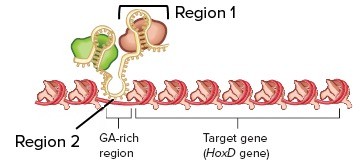A scientist is studying the HOTAIR ncRNA in human cells growing in culture. She identifies a mutation in a cell line that she suspects may affect the function of HOTAIR. The mutation changes the sequence in region 2 from 5?-CUCCCUU-3? to 5?-CUGGACG-3? (see diagram). How will this mutation affect the function of HOTAIR?
A. The mutant HOTAIR will bind to different target genes than the normal HOTAIR, but it will not inhibit their expression.
B. The mutant HOTAIR will bind to the same target genes as the normal HOTAIR, but it will not inhibit their expression.
C. The mutant HOTAIR will bind to different target genes than the normal HOTAIR, and it will inhibit their expression.
D. The mutant HOTAIR will not be produced.
E. There will be no difference in the function of the mutant and normal HOTAIR ncRNAs.
Answer: C
You might also like to view...
Which one of the following terms applies to the phylum Nematoda?
A. deuterostome B. diploblastic C. Parazoa D. pseudocoelomate
Which of the following is NOT produced in the ovaries?
a. oocytes b. gametes c. estrogen d. endometrium e. progesterone
The food web represented above does not include bacteria and fungi. Which of the following best describes a consequence of having no bacteria and fungi in the food web?
(A) Grasses will have no direct access to chemical components recycled from dead organisms. (B) Rabbits will have no direct access to energy absorbed from secondary consumers. (C) Shrews will have no direct access to matter transferred from tertiary consumers. (D) Hawks will have no direct access to nitrogen acquired from the atmosphere.
After attaching to a bacterial cell, a bacteriophage typically
A. injects DNA into the cell. B. transforms the cell into a virulent strain. C. extracts DNA from the cell. D. extracts protein from the cell. E. injects protein into the cell.